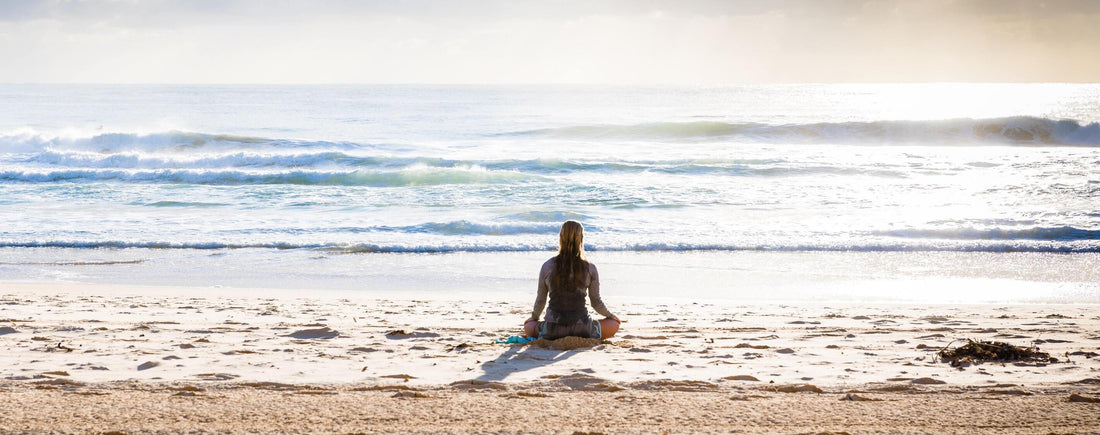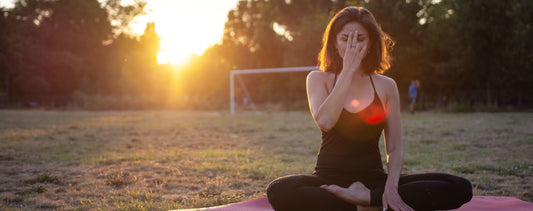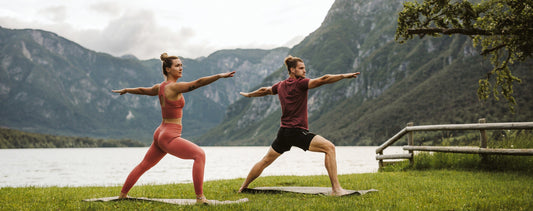We live in a world that is largely created using straight lines, boxes, and sharp angles. We see it in the steel frame of a new building being built, in the grid structure of big city streets, even on our highways, outlined in colors and dashed lines. It’s no wonder we crave routine in our daily lives, the world we live in guides us towards structure at every turn. When we get caught up in structure and hard lines it’s easy to forget the natural ebb and flow that we embody.
In nature, there are no hard lines, no sharp angles, and there is rarely complete stillness. Think of a still body of water, a lake, or a pond - even when described as still there is always gentle movement. The surface of the water ripples with the breeze. Beneath that, in the depths of the water, life carries on with fish and seaweed in movement beyond what we see at first glance. We are made of nearly 70% water and we so easily become frozen in our habits and routines. Over the course of days upon days of routine, we lose our sense of creativity, we lose our playful, buoyant nature, and we get stuck.
When the mind becomes frozen in habitual thought and the energy is blocked it manifests as tension in the physical body. As we move through asana practices, we can call on the element of water to clear away stagnation and invite in our natural ability to flow. To invoke this element on your mat and to access a level of fluidity, you might connect each breath to a new movement and create a dance with these shapes. As you move from one shape to the next, energy is stirred and transformed. In this process, anything that needs to be cleared away can be cleansed through this dance between mind, body, and spirit.
If you are called to hold a shape for a while longer, you might use your breath as a tool to bring about the sensation of buoyancy. The body may remain in relative stillness while the breath and the energy are guided to find their natural flow. The sustaining of all life depends on this ebb and flow, without the consistency of movement life would cease to exist.
As you bring the element of water into your practice, consider adding in a few of these shapes to allow yourself to return to your natural flow state.
Marjaiasana/Bitilasana
Begin in a tabletop position on your mat. Allow your palms to connect to the earth and your knees and toes to ground into your mat. As you inhale, lift your tailbone towards the sky, draw the shoulder blades together on the back body, and take the gaze towards the ceiling. With your exhale, spread your shoulder blades, draw your chin to your chest, and round the back body. Repeat this movement as many times as you’d like, every inhale lifts the gaze, and the tailbone towards the sky, every exhale the shoulder blades spread apart and the chin moves towards the chest. Connect each breath to each new movement, allow yourself to be guided by the pace of your breath.
Bhujangasana
From your tabletop position, walk your hands forward slightly to lower yourself onto the belly. Let your forehead rest on the mat, take your hands wider than the narrow width of your mat and slightly in front of the shoulders. Begin by activating the lower body by pressing the tops of the feet into the mat. On your inhale peel the heart away from the earth and gently lift your gaze, the ribs will stay connected to your mat. With your exhale let the body settle towards the mat. Repeat as many times as feels good, inviting each breath to take its time as it moves you from shape to shape.
Adho Mukha Svanasana to Plank Flow
Once you feel complete in your oscillating cobra movements, slide the hands closer to your shoulders and tuck your toes under. From there, press into your hands and feet to lift the hips up and back into a downward-facing dog, Adho Mukha Svanasana. As you’re ready on your next inhale, rise onto your toes, gently bend your knees, and shift your shoulders forward over your wrists making your way into plank position. With your exhale, shift the hips up and back to your downward-facing dog. Again, your inhale takes you forward towards plank pose, your exhales return you to downward-facing dog. Invite each movement and each breath to clear away stagnant energies and unserving thoughts.
Ashta Chandrasana to Parsvottanasana (Anjaneyasana to Ardha Hanumanasana)
From downward-facing dog, step your right foot forward towards your hands. The back left knee can be lowered to the mat or remain lifted. Keep your hands connected to the mat or blocks on either side of your right foot. On your inhale reach the crown of the head forward, as you exhale shift your hips back and straighten your right leg. Inhale, bend your right leg and come back into your lunge, exhale to straighten your front leg. Each breath will guide your movement at your pace, if one shape feels good allow yourself to stay there for a few breaths and invite the fluidity of the breath to bring in the element of water. When you’re ready, switch sides.
Eka Pada Rajakapotasana
To set up for pigeon pose, begin in downward-facing dog. Lift your right leg into the sky and bend your leg at the knee. Bring your right knee towards your right wrist, let your right ankle land towards your left wrist. Allow your knee to move out as wide as feels good for you and bring your heel as close to the pelvis as feels good, your shin does not have to be parallel to the front of your mat. Invite in any props to support your hip and heart to find a sense of ease and comfort in this shape. When you’re ready, walk your fingertips forward and surrender your heart towards the earth. If it feels good to be in stillness, stay here. If you’d like to invite movement you might sway the torso from side to side or lift the heart slowly away from the earth on your breath in and allow it to settle towards the earth on your breath out. When you’re ready to switch sides, find your way back to downward dog and repeat.
For another variation, you’re welcome to lay down on your back, bend one knee and cross your opposite ankle over the knee, creating a figure 4 shape. From here, reach one arm through the figure 4 shape and hold the back of the bottom leg or outside of the shin. Gently draw the knees toward your chest.
Supta Baddha Konasana
After taking your time on each side, make your way to a reclined position on your back body. Bring the soles of your feet together and allow your knees to drop out to either side. If your knees are asking for support, place blocks, blankets, or pillows under your knees to gently offer some grounding support. Let the body settle here for about 5 to 8 breaths. Bring the visualization of a body of water back into your space and notice the gentle ebb and flow of energy as the breath moves in and out.
Life is sustained in movement, connecting with the water element both on and off the mat is a beautiful way to be reminded of your own adaptability and power to transform. As you invite these practices into your world and find yourself nourished by the element of water you create an opportunity for harmony and ease. When you enter your own unique flow state and move with the fluidity of a stream of water, you create alignment to your highest self.
In your own exploration of this element, how can you invite in connection to water to cleanse, nourish, and transform your life?
Find more tools for nourishment and transformation with guided meditations and personalized practices in the Chopra App, available now.
In nature, there are no hard lines, no sharp angles, and there is rarely complete stillness. Think of a still body of water, a lake, or a pond - even when described as still there is always gentle movement. The surface of the water ripples with the breeze. Beneath that, in the depths of the water, life carries on with fish and seaweed in movement beyond what we see at first glance. We are made of nearly 70% water and we so easily become frozen in our habits and routines. Over the course of days upon days of routine, we lose our sense of creativity, we lose our playful, buoyant nature, and we get stuck.
When the mind becomes frozen in habitual thought and the energy is blocked it manifests as tension in the physical body. As we move through asana practices, we can call on the element of water to clear away stagnation and invite in our natural ability to flow. To invoke this element on your mat and to access a level of fluidity, you might connect each breath to a new movement and create a dance with these shapes. As you move from one shape to the next, energy is stirred and transformed. In this process, anything that needs to be cleared away can be cleansed through this dance between mind, body, and spirit.
If you are called to hold a shape for a while longer, you might use your breath as a tool to bring about the sensation of buoyancy. The body may remain in relative stillness while the breath and the energy are guided to find their natural flow. The sustaining of all life depends on this ebb and flow, without the consistency of movement life would cease to exist.
As you bring the element of water into your practice, consider adding in a few of these shapes to allow yourself to return to your natural flow state.
Cat/Cow Shapes
Marjaiasana/Bitilasana
Begin in a tabletop position on your mat. Allow your palms to connect to the earth and your knees and toes to ground into your mat. As you inhale, lift your tailbone towards the sky, draw the shoulder blades together on the back body, and take the gaze towards the ceiling. With your exhale, spread your shoulder blades, draw your chin to your chest, and round the back body. Repeat this movement as many times as you’d like, every inhale lifts the gaze, and the tailbone towards the sky, every exhale the shoulder blades spread apart and the chin moves towards the chest. Connect each breath to each new movement, allow yourself to be guided by the pace of your breath.
Oscillating Cobra Pose
Bhujangasana
From your tabletop position, walk your hands forward slightly to lower yourself onto the belly. Let your forehead rest on the mat, take your hands wider than the narrow width of your mat and slightly in front of the shoulders. Begin by activating the lower body by pressing the tops of the feet into the mat. On your inhale peel the heart away from the earth and gently lift your gaze, the ribs will stay connected to your mat. With your exhale let the body settle towards the mat. Repeat as many times as feels good, inviting each breath to take its time as it moves you from shape to shape.
Downward Dog to Plank Flow
Adho Mukha Svanasana to Plank Flow
Once you feel complete in your oscillating cobra movements, slide the hands closer to your shoulders and tuck your toes under. From there, press into your hands and feet to lift the hips up and back into a downward-facing dog, Adho Mukha Svanasana. As you’re ready on your next inhale, rise onto your toes, gently bend your knees, and shift your shoulders forward over your wrists making your way into plank position. With your exhale, shift the hips up and back to your downward-facing dog. Again, your inhale takes you forward towards plank pose, your exhales return you to downward-facing dog. Invite each movement and each breath to clear away stagnant energies and unserving thoughts.
Crescent Lunge to Pyramid Pose (Low Lunge to Half Split)
Ashta Chandrasana to Parsvottanasana (Anjaneyasana to Ardha Hanumanasana)
From downward-facing dog, step your right foot forward towards your hands. The back left knee can be lowered to the mat or remain lifted. Keep your hands connected to the mat or blocks on either side of your right foot. On your inhale reach the crown of the head forward, as you exhale shift your hips back and straighten your right leg. Inhale, bend your right leg and come back into your lunge, exhale to straighten your front leg. Each breath will guide your movement at your pace, if one shape feels good allow yourself to stay there for a few breaths and invite the fluidity of the breath to bring in the element of water. When you’re ready, switch sides.
Pigeon Pose
Eka Pada Rajakapotasana
To set up for pigeon pose, begin in downward-facing dog. Lift your right leg into the sky and bend your leg at the knee. Bring your right knee towards your right wrist, let your right ankle land towards your left wrist. Allow your knee to move out as wide as feels good for you and bring your heel as close to the pelvis as feels good, your shin does not have to be parallel to the front of your mat. Invite in any props to support your hip and heart to find a sense of ease and comfort in this shape. When you’re ready, walk your fingertips forward and surrender your heart towards the earth. If it feels good to be in stillness, stay here. If you’d like to invite movement you might sway the torso from side to side or lift the heart slowly away from the earth on your breath in and allow it to settle towards the earth on your breath out. When you’re ready to switch sides, find your way back to downward dog and repeat.
For another variation, you’re welcome to lay down on your back, bend one knee and cross your opposite ankle over the knee, creating a figure 4 shape. From here, reach one arm through the figure 4 shape and hold the back of the bottom leg or outside of the shin. Gently draw the knees toward your chest.
Reclined Bound Angle
Supta Baddha Konasana
After taking your time on each side, make your way to a reclined position on your back body. Bring the soles of your feet together and allow your knees to drop out to either side. If your knees are asking for support, place blocks, blankets, or pillows under your knees to gently offer some grounding support. Let the body settle here for about 5 to 8 breaths. Bring the visualization of a body of water back into your space and notice the gentle ebb and flow of energy as the breath moves in and out.
Life is sustained in movement, connecting with the water element both on and off the mat is a beautiful way to be reminded of your own adaptability and power to transform. As you invite these practices into your world and find yourself nourished by the element of water you create an opportunity for harmony and ease. When you enter your own unique flow state and move with the fluidity of a stream of water, you create alignment to your highest self.
In your own exploration of this element, how can you invite in connection to water to cleanse, nourish, and transform your life?
Find more tools for nourishment and transformation with guided meditations and personalized practices in the Chopra App, available now.






















